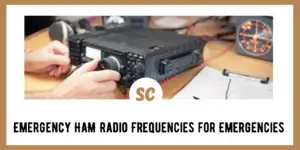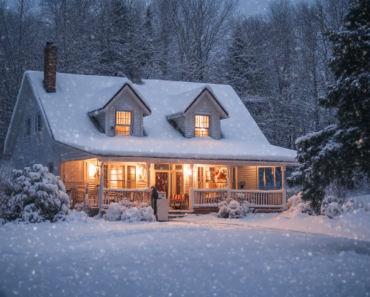Communications are essential in times of emergency. Maintaining situational awareness when things go bad is critical to the safety of you and your family.
Many people depend on their cell phones and social media for information. What happens when the complicated systems that support these communication networks is compromised?
There are some important ham radio frequencies you should understand in order to maintain emergency communications to connect with family and friends.
Additionally, to ensure that you can stay situationally aware, you need a system that doesn’t rely on the internet or the cell phone systems. Maintaining functioning emergency communication is one of the foundation stones of proper emergency preparedness.
The Amateur radio system and HAM radio operators have a long history of involvement in emergency communications around the world. HAM operates when most other communication systems fail. A licensed HAM operator will tell you that all they need is a battery, a radio, and a piece of wire for an antenna to keep communications open.
About the Amateur Radio Frequencies
In general, there are several different modes or classes of portable and base station radios that can be used for emergency communications.
Understanding how these frequencies are allocated, where and when they will work best, and what you need to use them is key.
In most situations, you need at least one of these emergency communications solutions. You may want to invest the time and effort to become proficient with more than one of them.
Radio Frequencies and HAM Radios
To begin, let’s take a look at the available equipment and the frequencies on which this equipment operates.
Once you are familiar with the equipment and its advantages and limitations, especially in the frequency ranges, you can make better decisions about which emergency communication equipment you need for your situation.
The Personal Radio Services
The best place to start talking about emergency communications frequencies is with those that are generally known as personal radio services.
These include the low-cost handheld radios that you can buy at almost any big box store, outdoor store, and all over the internet. This class of radios and radio frequencies includes:
Family Radio Service (FRS)
Most of the blister pack handheld radios you can purchase almost anywhere fall into this class. These radios use frequencies that are grouped into channels and the radios come preprogrammed with the frequencies.
There are 22 channels allocated in the 462 to 467 MHz range for these radios.
These radios, despite what some manufacturers advertise on the package, are usually not reliable for communications beyond a one-half mile in range. This range can be considerably less due to terrain or other factors. Even buildings in an urban environment can block these signals.
While these radios are inexpensive and easy to find, they are poor choices for most emergency communications applications.
Citizen Band Radios (CB)
In the seventies, CB radios were all the rage, and almost everyone had one. Like the FRS radios, CBs operate on a set of pre-programmed channels. In addition, to use CB radio legally, there are some restrictions and requirements made by the Federal Communications Commission.
CB radios are limited to a maximum power of twelve watts when operated in SSB modes. If you operate the radio in AM mode, power output is limited to four watts. CB radio frequencies fall between 26.965 and 27.405 MHz. There are forty channels allocated to the CB band.
The downside to CB radio frequencies is that local emergency management organizations typically don’t use the CB frequencies to communicate or broadcast information. These bands are limited to informal use among radio operators.
General Mobile Radio Service (GMRS)
The General Mobile Radio frequencies fall between 462 MHz and 467 MHz. These frequencies are divided into channels.
Most handheld radios will access the GMRS channels but there is a caveat. This is a licensed class of frequencies and you must have a GMRS license from the FCC to legally operate on these frequencies.
There is a huge amount of interest now in GMRS radio frequencies for emergency communications for several reasons.
- You can operate at higher power giving you more range for your communications.
- GMRS radios can be used with repeaters to extend the range and coverage. More about repeaters later in this article.
- More robust communications provide for the use of specialized equipment and communications systems.
Many local emergency management organizations and local ham club operators are using GMRS for emergency communications. Using linked repeaters, a wide area can be covered with a relatively low-power handheld radio.
Licensing and Operating in the Personal Use Frequency Area
With one exception, you can purchase and operate on the frequencies and channels authorized for these personal use radios without a license.
The one exception is the GMRS radios, which require you to acquire an FCC license.
There is no testing required to get a GMRS license. You can visit the FCC licensing website for more information and fill out an application for your GMRS license at this link.
One great thing about the GMRS license is it covers your immediate family. Any of your family members can operate a GMRS radio under the license.
Moving Along the Frequency Charts
If you need longer-range communications the next step up is to move into the ultra-high frequencies (UHF) and very high frequencies (VHF). These radios operate on frequencies that are more apt to provide more range and better communication quality than the personal radio service equipment.
In addition to more power, UHF and VHF frequencies are the home of many repeater sites that give added range to these radios. Repeaters, listen for a signal on the frequency and rebroadcast that signal at higher power, usually though a much better antenna.
The downside to UHF and VHF operations is the need to get an FCC license to legally operate on these frequencies. Your radio must also be capable of sending the correct information to the repeater and must be programmed to operate with the repeater.
Going Long – HF Radio Frequencies
For truly long range communications, you must operate in the HF bands. These high frequency bands range from 1 to 30 MHz and are capable, under the right conditions, of transmitting hundreds or even thousands of miles.
This gives you the capability to contact other HAMS many miles away, or even on a different continent.
Learning the Bands
HF frequencies are divided in to bands and each country determines which areas of these bands licensed HAM radio operators can access. In the U.S., the band plan chart issued by the FCC lays out like this:
- 160 Meters (1.8 MHz) – 1.8 to 2.00 MHz
- 80 Meters (3.5 MHz) – 3.50 to 4.00 MHz
- 60 Meters (5.3 MHz) – Divided into channels allocated to specific frequencies between 5.3305 and 5.4035 MHz
- 40 Meters (7 MHz) – 7.0 to 7.3 MHz
- 30 Meters (10.1 MHz) – 10.100 to 10.150 MHz
- 20 Meters (14 MHz) – 14.000 to 14.350 MHz
- 17 Meters (18 MHz) – 18.068 to 18.168 MHz
- 15 Meters (21 MHz) – 21.000 to 21.450 MHz
- 12 Meters (24 MHz) – 24.890 to 29.700 MHz
To make things a little more complicated, each band or frequency range is further divided into areas where only certain classes of license holders can operate.
To operate in the HF frequency ranges requires you to test and qualify for one of the amateur radio licenses.
Amateur Radio License Classes and Frequency Permissions
To operate a HAM radio on one of the frequency ranges you must apply for a license, take and pass the required test, and pay a fee to the FCC. In a nutshell, there are three amateur radio license classes:
1. Technician Class License
The most basic of the radio licenses issues by the FCC is the technician class. This class of license allows you to transmit to other HAMS on the VHF, UHF, and a very limited range of frequencies on the HF band.
On the HF frequencies, Technician License holders may only transmit on the 10 meter band using voice. If you can do Morse Code, there are more available opportunities.
The Technician Class license requires you to take a 35-question test and score a 70% or better. The test mostly covers rules and regulations, some operating methods, and a few technical questions.
2. General Class License
Most people who want to transmit on the HAM radio frequencies get their General Class License. A General Class License opens up most of the frequencies for voice, CW, or digital communications. Many Ham radio amateurs have no trouble finding frequencies on which to operate in the General Class ranges on the HAM bands.
The process to get a General Class License requires that you first qualify for a Technician license. The test is 35 questions consisting of practical rules and regulations, operating protocols, and more technical questions about radio frequencies and components.
3. Extra Class License
The Extra Class License is the pinnacle of amateur radio operations. Once you have and Extra Class Amateur Radio License, you can operate anywhere amateur radio operators are authorized by the FCC.
There are a lot fewer Extra Class License holders, which means those areas reserved for this class are much less used and often easier for finding frequencies.
The Extra Class license requires you to hold a general license and take a 50 question test which is much more technical in nature. The test covers circuits, electronic parts, antenna design and frequency selections. This is a much more challenging test and requires detailed study.
Making Application to Take a License Test
To obtain an amateur radio license, there are certain steps that you must take. The process is relatively easy if you follow the instructions and perform the required prerequisites.
- I suggest that you first find a local HAM club that offers testing. The FCC required tests are administered by local volunteer test examiners and often local hams and ham radio clubs give tests on a regular basis. Finding a local club with some friendly HAMS is a great way to get started in amateur radio.
- If you decide to go on your own, the first step is to visit the FCC licensing website. This requires that you first register for an account. This is easily done by visiting the web page at this link.
- Once you have your account created with the FCC, you should find a testing center that administers the tests, sign up and begin studying for your Technician Level test. There are many good practice website options to use for studying.
The amateur frequencies provide an excellent opportunity to practice and get on the air. You don’t need a license to monitor the ham radio frequencies.
You can listen to you hearts content as other amateurs on the HF bands give you an opportunity to hear what goes on when the HF bands are active.
FAQS About Emergency Comms and Radio Frequencies
There are some fallacies and some misunderstandings about using HAM radio frequencies during emergencies and how to prepare for a crisis situation where communications can be critical to you and your families safety and well-being.
I Have a HAM radio. Can I Use it without a License?
There are no prohibitions about buying or owning a HAM radio without a license. You can listen and monitor the frequencies all you want.
For example, many people enjoy listening to shortwave broadcasts from other countries. This is a great way to get current news. Just don’t forget that you must have a license to press the key and transmit over the air.
Do I need a Huge Antenna?
Probably not. Most HAM radio frequencies can be very successfully used by connecting a simple wire antenna. There are vertical antennas that are easy to mount in confined areas or small yards that allow you to connect without interference or a huge footprint.
Some handheld UHF and VHF radios work extremely well with the short flexible antennas on the radio. Adding an external antenna will help but isn’t strictly necessary.
What is a Good Way to Maintain Emergency Communications with my Family?
If you want to have a backup emergency communications system for you family, I suggest that you invest is some quality GMRS capable radios. The frequencies that these radios use give you a range of options.
Just remember that the maximum power is limited and the maximum range of these radios may be limited by both terrain and distance.
These GMRS radios are inexpensive enough to outfit your entire family, handy enough to keep in a car or go bag, and one license can cover all of your family members.
Which Frequencies are the best for Emergency Communications?
No one frequency will do everything. The UHF, VHF, and GMRS frequencies are great for portability and short range communications.
If repeaters remain active, you can expect to have a communication range of cup to 50 or 60 miles in some cases. The power of your signal will depend on the quality of the radio, the environment and terrain, and what frequency you select.
If you need more distance from your location, investing the time and money to get licensed and to set up a ham radio location is wise.
HF radios are limited to 15oo watts of broadcast power giving you almost unlimited range. However, even at maximum power, other hams may not hear your signal or you may not be able to receive theirs.
I suggest that anyone preparing for an emergency situation take the time to get at least a technicians license and invest in a good UHF or VHF radio and an appropriate antenna. You can buy mobile radios that operate on both the UHF and VHF bands giving you a lot of flexibility.
These frequencies are typically utilized by emergency operations to broadcast information and news during emergencies.
Doesn’t the Law Allow me to Use a HAM radio in Emergencies?
To a certain extent, this is true.
If you are in a life-threatening situation you may use any radio to summon help. However, the key phrase here is life-threatening.
Your situation must be dire to qualify for this exemption, and then you can only use the radio frequencies to summon help and give them your location.
Being stuck on the highway with a flat tire and no cell phone service does not qualify as life-threatening. Be sure that you are fully aware of the laws before you start broadcasting on any frequency with any radio. The fines levied can be hefty.
My Final Thoughts
Staying in touch is a critical part of an emergency pre-plan. There are many ways to maintain communications when the cell phone infrastructure becomes unusable. HAM radio is one way that has been proven over the years to work.
It doesn’t matter if you decide to rely on simple handheld radios and the GMRS frequencies or go the full route. Knowing that you can communicate with your family, friends, and the outside world in the event of a calamity can bring a great deal of peace of mind.













![Lights Out Kit, Preparedness Levels, & WWIII [PODCAST] Lights Out Kit, Preparedness Levels, & WWIII [PODCAST]](https://survivalcove.com/wp-content/uploads/2021/11/survival-preppers-podcast-banner-370x297.jpg)




















